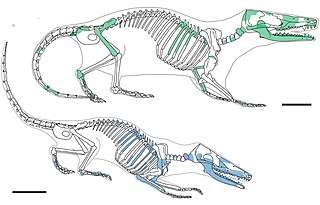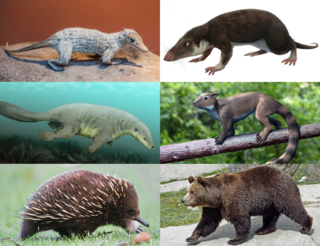
Multituberculata is an extinct order of rodent-like mammals with a fossil record spanning over 130 million years. They first appeared in the Middle Jurassic, and reached a peak diversity during the Late Cretaceous and Paleocene. They eventually declined from the mid Paleocene onwards, disappearing from the known fossil record in the late Eocene. They are the most diverse order of Mesozoic mammals with more than 200 species known, ranging from mouse-sized to beaver-sized. These species occupied a diversity of ecological niches, ranging from burrow-dwelling to squirrel-like arborealism to jerboa-like hoppers. Multituberculates are usually placed as crown mammals outside either of the two main groups of living mammals—Theria, including placentals and marsupials, and Monotremata—but usually as closer to Theria than to monotremes. They are considered to be closely related to Euharamiyida and Gondwanatheria as part of Allotheria.
Hahnodon is an extinct genus of mammaliaforms from the Early Cretaceous Ksar Metlili Formation in Morocco. Although originally considered to be a relatively early member of the extinct clade Multituberculata, recent studies indicate that it instead is a haramiyid.
Hahnodontidae is a family of extinct mammaliaforms from Early Cretaceous deposits in Morocco and the Western United States. Although originally considered to belong to the extinct clade Multituberculata, recent work indicates that hahnodontids belong to the more primitive clade Haramiyida.

Castorocauda is an extinct, semi-aquatic, superficially otter-like genus of docodont mammaliaforms with one species, C. lutrasimilis. It is part of the Yanliao Biota, found in the Daohugou Beds of Inner Mongolia, China dating to the Middle to Late Jurassic. It was part of an explosive Middle Jurassic radiation of Mammaliaformes moving into diverse habitats and niches. Its discovery in 2006, along with the discovery of other unusual mammaliaforms, disproves the previous hypothesis of Mammaliaformes remaining evolutionarily stagnant until the extinction of the non-avian dinosaurs.

Docodonta is an order of extinct mammaliaforms that lived during the Mesozoic, from the Middle Jurassic to Early Cretaceous. They are distinguished from other early mammaliaforms by their relatively complex molar teeth, from which the order gets its name. Until recently, Docodonta were represented primarily by teeth and jaws found across former Laurasia,. However, recent discoveries in China include some exceptionally well preserved, almost complete body fossils.

Mammaliaformes is a clade that contains the crown group mammals and their closest extinct relatives; the group radiated from earlier probainognathian cynodonts. It is defined as the clade originating from the most recent common ancestor of Morganucodonta and the crown group mammals; the latter is the clade originating with the most recent common ancestor of extant Monotremata, Marsupialia, and Placentalia. Besides Morganucodonta and the crown group mammals, Mammaliaformes includes Docodonta and Hadrocodium as well as the Triassic Tikitherium, the earliest known member of the group.

Volaticotherium antiquum is an extinct, gliding, insectivorous mammal that lived in Asia during the Jurassic period, around 164 mya. It is the only member of the genus Volaticotherium.

The evolution of mammals has passed through many stages since the first appearance of their synapsid ancestors in the Pennsylvanian sub-period of the late Carboniferous period. By the mid-Triassic, there were many synapsid species that looked like mammals. The lineage leading to today's mammals split up in the Jurassic; synapsids from this period include Dryolestes, more closely related to extant placentals and marsupials than to monotremes, as well as Ambondro, more closely related to monotremes. Later on, the eutherian and metatherian lineages separated; the metatherians are the animals more closely related to the marsupials, while the eutherians are those more closely related to the placentals. Since Juramaia, the earliest known eutherian, lived 160 million years ago in the Jurassic, this divergence must have occurred in the same period.

Eutriconodonta is an order of early mammals. Eutriconodonts existed in Asia, Africa, Europe, North and South America during the Jurassic and the Cretaceous periods. The order was named by Kermack et al. in 1973 as a replacement name for the paraphyletic Triconodonta.

Haramiyida is a possibly polyphyletic order of mammaliaform cynodonts or mammals of controversial taxonomic affinites. Their teeth, which are by far the most common remains, resemble those of the multituberculates. However, based on Haramiyavia, the jaw is less derived; and at the level of evolution of earlier basal mammals like Morganucodon and Kuehneotherium, with a groove for ear ossicles on the dentary. If they are early multituberculates, they would be the longest lived mammalian clade of all time. However, a more recent study in November 2015 may dispute this and suggested the Haramiyida were not crown mammals, but were part of an earlier offshoot of mammaliaformes instead. It is also disputed whether the Late Triassic species are closely related to the Jurassic and Cretaceous members belonging to Euharamiyida/Eleutherodontida, as some phylogenetic studies recover the two groups as unrelated, recovering the Triassic haramiyidians as non-mammalian cynodonts, while recovering the Euharamiyida as crown-group mammals closely related to multituberculates.

Morganucodonta is an extinct order of basal Mammaliaformes, a group including crown-group mammals (Mammalia) and their close relatives. Their remains have been found in Southern Africa, Western Europe, North America, India and China. The morganucodontans were probably insectivorous and nocturnal, though like eutriconodonts some species attained large sizes and were carnivorous. Nocturnality is believed to have evolved in the earliest mammals in the Triassic as a specialisation that allowed them to exploit a safer, night-time niche, while most larger predators were likely to have been active during the day.

Kuehneotherium is an early mammaliaform genus, previously considered a holothere, that lived during the Late Triassic-Early Jurassic Epochs and is characterized by reversed-triangle pattern of molar cusps. Although many fossils have been found, the fossils are limited to teeth, dental fragments, and mandible fragments. The genus includes Kuehneotherium praecursoris and all related species. It was first named and described by Doris M. Kermack, K. A. Kermack, and Frances Mussett in November 1967. The family Kuehneotheriidae and the genus Kuehneotherium were created to house the single species Kuehneotherium praecursoris. Modeling based upon a comparison of the Kuehneotherium jaw with other mammaliaforms indicates it was about the size of a modern-day shrew between 4 and 5.5 g at adulthood.
Several mammals are known from the Mesozoic of Madagascar. The Bathonian Ambondro, known from a piece of jaw with three teeth, is the earliest known mammal with molars showing the modern, tribosphenic pattern that is characteristic of marsupial and placental mammals. Interpretations of its affinities have differed; one proposal places it in a group known as Australosphenida with other Mesozoic tribosphenic mammals from the southern continents (Gondwana) as well as the monotremes, while others favor closer affinities with northern (Laurasian) tribosphenic mammals or specifically with placentals. At least five species are known from the Maastrichtian, including a yet undescribed species known from a nearly complete skeleton that may represent a completely new group of mammals. The gondwanathere Lavanify, known from two teeth, is most closely related to other gondwanatheres found in India and Argentina. Two other teeth may represent another gondwanathere or a different kind of mammal. One molar fragment is one of the few known remains of a multituberculate mammal from Gondwana and another has been interpreted as either a marsupial or a placental.
Arboroharamiya is an extinct genus of early mammal from the Middle Jurassic Tiaojishan Formation of Inner Mongolia, China. Arboroharamiya belongs to a group of mammaliaforms called Haramiyida. The type species Arboroharamiya jenkinsi was described in the journal Nature in 2013 alongside a description of the closely related haramiyidan Megaconus. Unlike Megaconus, which is thought to have been ground-dwelling, Arboroharamiya was arboreal. It has a long tail that might have been prehensile, and very long fingers. Based on the shape of its teeth, Arboroharamiya might have been an omnivore or a seed eater. Recent interpretations of its specimen suggest that it possessed patagia and was a glider.

Shenshou is a genus of haramiyidan dating from the Oxfordian stage of the Late Jurassic, approximately 160 million years ago. Fossils were recovered from the Tiaojishan Formation in the Liaoning province of China.

Euharamiyida also known as Eleutherodontida, is clade of early mammals or mammal-like cynodonts from the Middle Jurassic to Early Cretaceous of Eurasia and possibly North America. The group is sometimes considered a sister group to Multituberculata, or part of an earlier divergence within the synapsid line. It is disputed whether or not they are related to the Haramiyids from the Late Triassic, such as Haramiyavia. The morphology of their teeth indicates that they were herbivorous or omnivorous. Some members of the group are known to be arboreal, including gliding forms similar to modern flying squirrels or colugos.
Wareolestes rex is a mammaliaform from the Middle Jurassic (Bathonian) rocks of England and Scotland. It was originally known from isolated teeth from England, before a more complete jaw with teeth was found in the Kilmaluag Formation of Skye, Scotland.
Vilevolodon is an extinct, monotypic genus of volant, arboreal euharamiyids from the Oxfordian age of the Late Jurassic of China. The type species is Vilevolodon diplomylos. The genus name Vilevolodon references its gliding capabilities, Vilevol, while don is a common suffix for mammalian taxon titles. The species name diplomylos refers to the dual mortar-and-pestle occlusion of upper and lower molars observed in the holotype; diplo, mylos.
Cifelliodon is an extinct genus of mammaliaforms from the Lower Cretaceous of North America. In the describing paper, it was considered one of the latest surviving haramiyids yet known, belonging to the family Hahnodontidae. Its discovery led to the proposal to remove hahnodontids from the larger well-known group, the multituberculates. However, later papers have considered it to be a basal allotherian outside of Haramiyida.

Kermackodon is an extinct genus of allotherian mammal, known from the Middle Jurassic of England. It combines features of multituberculates with those of euharamyidans. The remains of type species, K. multicuspis were collected from Kirtlington Quarry in Oxford, England, by a team lead from UCL led by Professor Kenneth Kermack after whom the taxon is named, from sediments of the Forest Marble Formation, dating to the Bathonian stage of the Middle Jurassic. The genus and species were named by Percy M. Butler and Jerry Hooker in 2005. The remains comprise a left upper molar (M2), a lower last premolar, initially considered a left but later considered more likely to be right (p4), and an incomplete non-last upper premolar. A second species, K. oxfordensis, from Kirtlington and also sediments of the White Limestone Formation at Woodeaton Quarry was assigned to the genus in 2022, originally placed in the separate genus Eleutherodon. A 2020 study considered it to be more closely related to mutlituberculates than to euharamiyidans, while the 2022 study considered it to be a member of Euharamiyida.




















